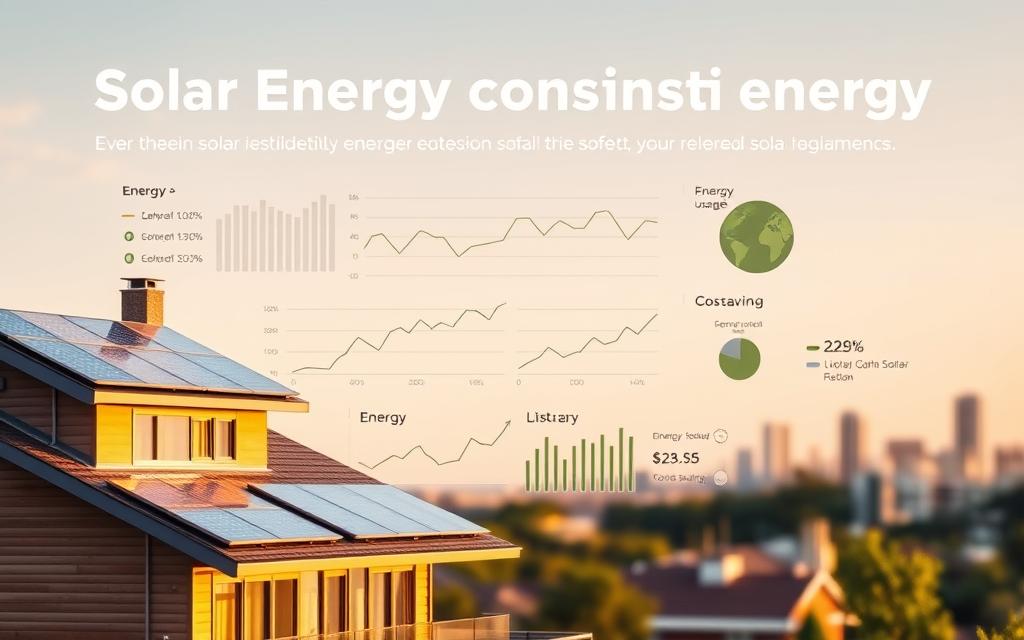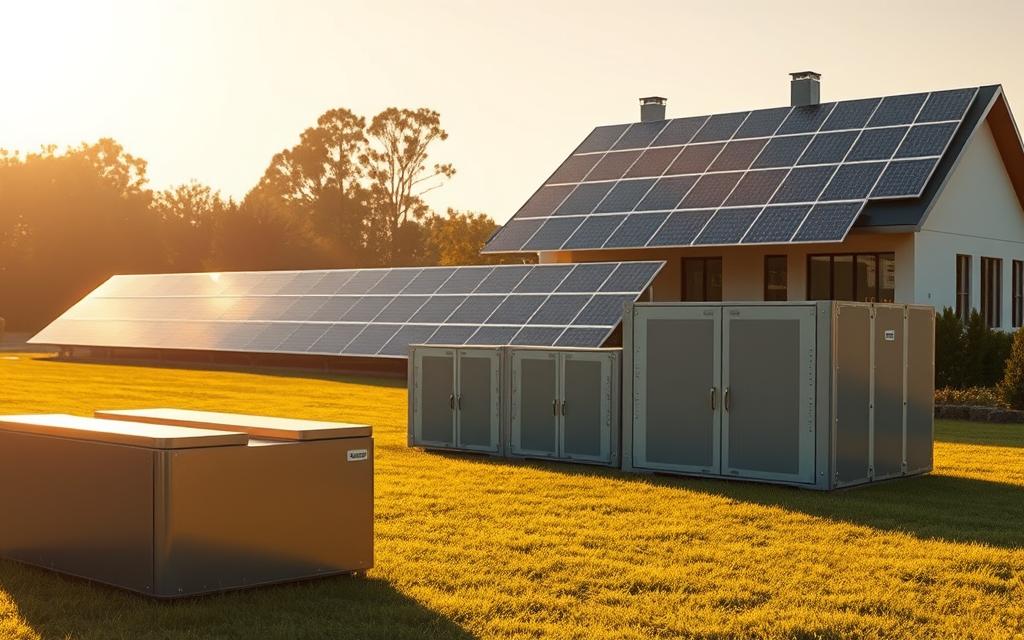Did you know only 12% of U.S. homeowners use solar battery storage? This is despite the fact that it can cut energy costs a lot. Home solar batteries are key to using solar energy from rooftop panels better.
They store extra electricity for later use. This boosts energy independence and saves money. As more people want to live sustainably, learning about solar battery storage is crucial.
What Is Solar Battery Storage?
Solar battery storage systems are key in using renewable energy. They collect and store extra electricity from solar panels. Homeowners get a reliable backup for energy when the sun isn’t shining or during outages.
Definition and Purpose
Solar battery storage captures and stores extra energy from solar panels. Its main goal is to make energy more accessible for homeowners. Using solar energy storage solutions can lower electricity bills and boost energy independence.
How It Differs from Traditional Batteries
Traditional batteries are made for quick power needs. Solar battery storage systems, however, are built for longer use. They are perfect for renewable energy, offering a sustainable way to manage energy.
Benefits of Solar Battery Storage
Solar battery storage systems bring many benefits to homeowners. They change how we use and manage energy. These systems save money, increase energy freedom, and are good for the planet. Knowing these benefits helps homeowners choose solar battery backup for their energy needs.
Cost Savings on Energy Bills
One big advantage of solar battery storage is lower energy bills. Homeowners can save energy made during the day for later. This saves money and makes electricity costs more stable.
Increased Energy Independence
Solar battery backup gives homeowners more energy freedom. They can use their own solar power instead of the grid during outages. This means they always have power, even when the grid fails.
Backup Power During Outages
Solar battery storage is key for backup power during outages. It lets homeowners keep important things running at home. This is especially helpful in areas with often broken power.
Environmental Impact
Using solar battery storage helps the environment. It cuts down on fossil fuel use and lowers greenhouse gas emissions. This makes energy cleaner and helps fight climate change.
How Solar Battery Storage Systems Work
Homeowners need to understand how solar battery storage systems work. These systems save extra energy from solar panels. This energy is used when there’s less sunlight or when more power is needed. We’ll look at how they charge, the AC vs. DC difference, and how energy management systems help use stored energy wisely.
The Charging Process
When solar panels make more energy than needed, the extra goes to storage systems. This process turns DC electricity from solar panels into battery-storable energy. During sunny times, batteries fill up, ready to power homes when it’s not sunny.
Powering Your Home: AC vs. DC
Knowing the difference between AC and DC energy is key. Solar panels make DC power, but homes use AC. Inverters change DC to AC, letting homes use stored energy in appliances. This difference affects how solar energy fits into daily life.
Energy Management Systems
Energy management systems connect solar power and battery storage. They watch energy use and production, deciding when to charge batteries or use power. This smart tech is crucial for getting the most out of solar energy and using it efficiently.
Different Types of Solar Batteries
The market has many home solar batteries, each with its own benefits. Knowing these options helps homeowners choose the best renewable energy storage systems for their needs.
Lithium-Ion Batteries
Lithium-ion batteries are now the top choice for solar energy storage. They pack a lot of energy in a small space. Plus, they last up to 15 years or more with little upkeep.
They charge and discharge efficiently, making them perfect for home solar systems.
Lead-Acid Batteries
Lead-acid batteries are cheaper upfront for those starting with renewable energy. They’re easy to install but don’t last as long as lithium-ion batteries, lasting 3 to 5 years. They also need more care, like checking fluid levels and reconditioning.
Flow Batteries
Flow batteries are a new tech in home solar batteries. They’re not as common for homes but great for big energy storage needs. They last a long time and can grow with your energy needs.
Their design lets you easily add more energy capacity, making them good for big storage needs.
| Type of Battery | Energy Density | Typical Lifespan | Maintenance | Cost |
|---|---|---|---|---|
| Lithium-Ion | High | 15+ years | Low | Higher |
| Lead-Acid | Medium | 3-5 years | High | Lower |
| Flow | Variable | 20+ years | Low | Medium |
Key Considerations for Installation
When you’re looking to install solar batteries, there are key things to think about. First, you need to make sure you have enough space for the batteries. This space should also allow for good airflow to keep the batteries working well.
It’s also important to check if your current solar system can work with the new batteries. You’ll need to make sure the inverters are compatible. Knowing the local rules and any incentives for using solar batteries can also help a lot.
Space Requirements
Finding the right space for your solar battery system is crucial. The area should be well-ventilated and protected from harsh weather. Different types of batteries, like lithium-ion, might need less space than others, like lead-acid.
Make sure the space you choose is big enough for maintenance and checking the system’s performance.
Compatibility with Existing Solar Systems
Checking if your solar battery will work with your current system is key. You need to know what kind of inverter you’ll need for it to work right. Both the battery and inverter must match to store and use energy efficiently.
Getting help from a professional can make this step easier, especially if your setup is complex.
Local Regulations and Incentives
Knowing the local rules for solar energy is important for installing your system. These rules can change depending on where you live, affecting how you install and what you need to do. Looking into incentives, like tax breaks or rebates, can also save you money.
Local governments or utility companies often have resources to help you find these incentives. It’s worth exploring these options.
Evaluating Your Energy Needs
When thinking about solar battery storage, knowing your energy needs is key. A detailed solar energy consumption assessment helps you understand how much energy you use daily. This helps you pick the right battery size for your solar storage, making sure you have enough power without wasting it.
Understanding Your Energy Consumption
Start by tracking how much energy your home uses. Look at your energy bills from the past year to see how your usage changes. If you use more energy in certain months, you might need a bigger energy reserve.
Think about these things when you’re figuring out your energy use:
- How many people live in your home
- What appliances you use
- How energy use changes with the seasons
Determining Battery Size and Capacity
After you know how much energy you use, finding the right battery size is easy. You want a battery that can store enough energy for when you use the most. Here are some important equations to remember:
- Daily Energy Needs (kWh) = Total Usage divided by Days in Month
- Battery Size (kWh) = Daily Energy Needs multiplied by Days of Autonomy desired
Using these equations helps you pick a battery that will keep your solar energy system running smoothly, even when the sun isn’t shining.

| Appliance | Average Daily Usage (kWh) |
|---|---|
| Refrigerator | 1.5 |
| Lighting | 2.0 |
| Heating/Cooling System | 6.0 |
| Television | 0.5 |
| Other Electronics | 1.0 |
By understanding your needs and choosing the right battery size, you can make the most of solar battery storage. This will help power your home efficiently.
When to Use Solar Battery Storage
Knowing when to use solar battery storage is key to saving energy at home. It’s great for many situations, helping homeowners be energy independent. It’s also important to know how energy use changes with the seasons.
Ideal Situations for Installation
There are many good times to get solar battery storage. If you often lose power, a solar battery backup is a lifesaver. It keeps your lights on when you need them most.
Also, if you live where the sun shines bright but the grid is unreliable, solar batteries are a must-have. They make sure you always have power.
- Living in regions prone to blackouts
- Seeking energy independence during peak usage seasons
- Utilizing plentiful sunlight for off-grid living
Seasonal Variations in Energy Needs
Energy use changes with the seasons. Homes use more in summer and winter. Solar battery storage helps balance these changes.
In summer, when it’s sunny, you can store extra energy for later. This is great for families using a lot of air conditioning. In winter, when it’s not as sunny, you need enough battery storage to make up for the lack of solar energy.
By understanding these seasonal changes, homeowners can plan better. They can make sure they have enough power all year round.
Costs Associated with Solar Battery Storage
When it comes to solar battery storage, the cost is a big factor for homeowners. It’s not just about the initial price. You also need to think about how much you’ll save on energy bills in the long run. This section will help you understand these costs, including maintenance and warranties, so you can make an informed choice.
Initial Investment vs. Long-Term Savings
Getting solar battery storage can cost a lot upfront, from $5,000 to $15,000. But, the savings you get from using less energy can make it worth it. With the right system, you can cut down on your monthly bills and be more energy independent.
Maintenance and Warranty Considerations
Keeping solar batteries running is usually cheaper than traditional systems. You might just need occasional software updates and routine checks. It’s also key to get a good warranty. A 10-year warranty shows the maker’s confidence in their product’s durability.
| Item | Estimated Cost | Notes |
|---|---|---|
| Initial Battery Cost | $5,000 – $15,000 | Cost varies based on capacity and type |
| Installation | $1,000 – $3,000 | Dependent on local labor rates |
| Maintenance | $100 – $300/year | Includes routine checks |
| Warranty | 10 years | Standard duration from most manufacturers |
Future of Solar Battery Storage
The future of solar battery storage looks bright. New technologies aim to make it more efficient, safe, and affordable. Innovations in battery chemistry, like lithium-ion and solid-state batteries, will boost performance. As research and development grow, solar batteries will last longer and work better, opening up new possibilities for homeowners.
Technological Advancements
Smart battery systems are becoming a big deal in solar tech. They use advanced energy management to optimize charging and discharging. Also, new battery recycling tech is coming, making energy storage more eco-friendly and supporting energy independence.
Growing Market Trends and Opportunities
The market for solar battery storage is expanding fast. More people are choosing solar batteries for energy savings and to protect against rising energy costs. With utility companies and governments supporting green tech, the link between solar energy and battery storage will get stronger. This will help create a more sustainable future for solar storage.



